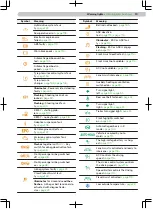
▶
In pregnant women, the lap belt part must be as
low as possible on the pelvis, so that no pressure is
exercised on the abdomen.
▶
The webbing must not be pinched or twisted and
rub against sharp edges.
▶
The webbing must not pass over solid or fragile
objects in clothing, such as a key ring, etc.
▶
The tongue may only be inserted into the buckle of
the associated seat.
▶
The webbing must be tight. Therefore, do not at-
tach clamps or similar items to the webbing for ad-
justing the seat belt according to body size.
Correct steering wheel position
▶
Hold the steering
wheel with both hands
on the outer edge in
the "9 o'clock" and "3
o'clock" position. Oth-
erwise, you may expe-
rience serious injury to
the arms, hands and
head when deploying
the airbag.
Be mindful of the effect of the airbag system
Airbag systems can only properly protect if all occu-
pants have been secured and they are in the correct
seating position.
No persons, animals or objects such as cup holders
or hangers for clothes may be in the deployment
area of the airbags
▶
Do not cover or stick anything over the steering
wheel or the dash panel. The front airbags were
not able to deploy.
The front passenger airbag should be switched off in
.
Securing children properly
▶
Do not carry a child on your lap, and secure the
child and yourself with a seat belt.
▶
Only transport children in a suitable child
seat
Children under 150 cm tall will not be properly pro-
tected without a child seat. Children that have been
inadequately secured can be thrown through the ve-
hicle in the event of an accident or a sudden ma-
noeuvre. You can cause life-threatening injuries to
yourself and other occupants.
If children lean forward or assume a wrong sitting
position while driving, they are more likely to be in-
jured in the event of an accident. This is especially
true for children who are carried in the passenger
seat - when the airbag system triggers, they can be
seriously injured or killed!
A child that has been incorrectly secured in the
wrong sitting position - endangered by the side
airbag
The child should not be
in the deployment area
of the side airbag.
A child that has been properly secured in a child
seat
There must be enough
room between the child
and the exit area of the
side airbag for the side
airbag to offer the best
possible protection.
Transporting objects safely
When moving heavy objects, there is a shift in em-
phasis. Thus, the driving behaviour of the vehicle
changes.
▶
Adjust driving speed and driving style to this
changed driving behaviour.
Unsecured or misplaced items may be thrown
around in the event of an accident or sudden ma-
noeuvre. There is a risk of serious injury and loss of
control of the vehicle!
In a rear-end collision at 50 km/h unsecured objects
are thrown forward with up to 50 times their weight.
A 1.5 litre water bottle is thrown with up to 75 kg.
▶
Transport objects securely.
▶
Stow objects so they do not hinder the driver.
Keep the driver footwell clear.
▶
Stow small items in the storage compartments.
▶
Do not leave lockable storage compartments open.
▶
Do not let items protrude out of the slots. This
note does not apply to bottles in bottle trays.
▶
Do not place any objects on the dash panel or on
the luggage compartment cover.
▶
Do not exceed the maximum permissible load of
fasteners and shelves.
▶
Distribute the load evenly in the luggage compart-
ment and fasten it so it cannot slip.
▶
Place heavy objects in the luggage compartment
as far forward as possible.
21
Correct and safe › Before your journey
















































